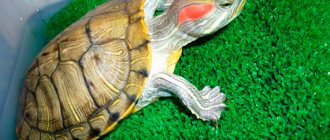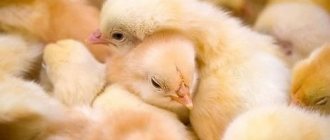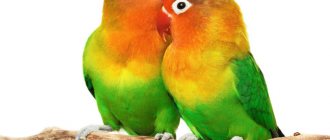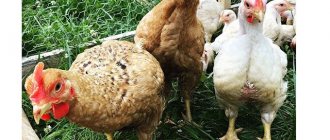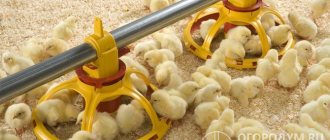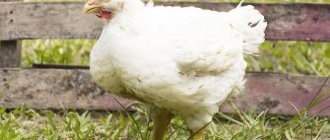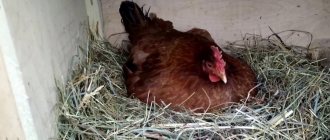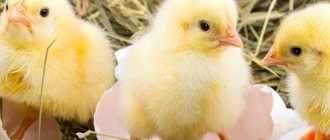2 436
no comments yet
0
Author:
Rasskazov Pavel.
Reading time: 3 minutes
Young animals are purchased for the purpose of obtaining egg or meat products, for selection or breeding for sale. Hence the need arises to determine the sex of individuals.
Caring for day-old chicks
Some farmers believe that chicks should be fed on the first day after birth.
Others advise waiting a day. The fact is that after leaving the egg, the chickens’ bodies have enough of the nutrients that they received while still inside. The supply runs out within 24 hours. After this time, it is imperative to feed and drink the babies. For both broiler chickens and laying hens, it is best to use a special “Start” mixture (of the appropriate variety). You can also feed the chicks with regular boiled eggs and millet. After a couple of days they usually start giving cottage cheese.
Special drinking bowls should be used for chicks. Ordinary little chicks can crawl into them or simply fall and get wet. This often causes the death of chicks. The fact is that when the feathers get wet, the baby’s body becomes severely hypothermic. This is especially true for broilers. If a wet chick is overlooked, it should be dried as quickly as possible and placed in the warmest possible place.
Further care
From the age of ten days, chickens begin to be fed fish or slaughterhouse waste. They are considered especially useful for broilers. During this period, the box with the chicks should be illuminated approximately 14 hours a day. The most comfortable temperature for chickens older than ten days is 20-24 degrees. At this time, laying hens can be left outside for the whole day and brought home only at night. Later, the chickens are transferred to a shed specially designated for them.
From the age of twenty days, laying hens usually begin to be given mash (at lunch) and grains (morning and evening). At this time, broiler chickens should already receive boiled mashed potatoes (in small quantities), fresh cottage cheese, buttermilk, etc. That is, the chickens are gradually transferred to an adult diet.
Traditional methods - how to determine the sex of a chicken
There are several ways to solve this issue (how to determine the sex of a chicken). And in this matter, folk wisdom is in no way inferior to science and is used in practice on an equal basis with all scientific methods. So, let's look at them in order:
- One method for determining the sex of a chick is to grab it by the scruff of the neck and observe how the chick holds its legs. A female chick, that is, a hen, will try to curl her claws and raise her legs. But the “male” individual’s paws will hang straight.
- The second method for determining the sex of a chicken is to study its behavior when picked up by its legs. According to this method, future hens will raise their heads up, and the future rooster will hang calmly.
- If you have an incubator, you can notice the sequence that the first chicks hatched are in most cases hens, and those that appear later will be cockerels.
- As they grow older, females and males behave differently from each other. If the chicks are about three weeks old or older, then in a stressful situation for them they behave differently in accordance with their gender. If you frighten them, the future cockerels will stand on the defensive with their heads held high. However, the chickens will pretend to be motionless, lower their heads and sit down.
- You can also determine the sex of a chicken by the color of its comb. In chickens it is small and yellowish. Whereas in males it is more noticeable and has a red color. This allows chicks to be sorted with great precision.
- You can also identify male and female chickens by the color of their down. Chickens of various colored breeds have peculiar spots or stripes on their heads, but cockerel chickens do not have these distinctive signs. Another sign is the plumage. It is very easy to determine the sex of chickens; cockerels fledge later than hens.
"Pedigree" method
The whole secret of this method is that in some breeds of birds the chicks differ in color. Their gender becomes clear immediately after hatching.
Leghorn and Legbar
The hatched day-old chicks differ from each other in color: the plumage of future laying hens is monochromatic, and the cockerels are immediately born striped.
Day old white Leghorn chicks
Brahma
The backs of small females of this breed are decorated with stripes, as well as dots located on the head. Their plumage pattern is very clear, while that of males will always be blurred.
Chickens of the Brama breed
Rhode Island, New Hampshire
On the second day of their existence, hens of this breed acquire dark stripes and spots on their heads, while the roosters remain with the same color.
Representatives of the Rhode Island breed
Adler silver
Distinguishing the sex of these chicks is easy. Newborn females have a characteristic bright yellow plumage color, and males have a lemon color. The head of the latter is decorated with a bright black stripe on the crown.
Adler silver chickens
Those farmers who breed the breeds listed above are definitely lucky. However, what should those who have all the chicks look the same do? Let's take a closer look at the ancient methods of determining sex that were invented by our ancestors.
At different ages
You can distinguish between roosters and hens at different ages, knowing some of the features of this age. Experienced poultry farmers have ensured that chicks and adults can be identified.
Daily age
It is almost impossible to independently see the differences between chickens in 1 day. Of course, you can try the reflex method and place the chicken on your palm, belly up. In this case, the male will resist and move actively, while the female will remain calm.
Usually, at poultry farms, chickens are separated from roosters in advance, because females are a little more expensive.
Weeks of age
You can see differences in a week-old chicken using the reflex method or by the position of the wings. These birds are old enough to see their reaction or examine the structure of the feathers on their wings.
Monthly age
At 1 month, the chicks are easy to distinguish externally. Hens fledge earlier and faster than cockerels. But the males are larger and more massive. At about the same age, external sexual characteristics can be noticed: the cockerel's genital tubercle will rise above the surface, in contrast to the neat knot of the chicken.
Age 2-4 months
By the age of two months, the cockerels acquire a comb and beard, their spurs clearly stand out, and their legs become more powerful and longer. Males have braids (rounded feathers) in their tails. Females are not attractive in appearance.
At 3 months the differences become even more noticeable. The comb, beard and spurs become even larger. By this same age, the cockerel can begin to “develop a voice.” At first it’s just too active squeaking and shouting over other chickens.
Age from 5 months
At 5-6 months, hens can begin to lay eggs, which will be the most accurate determination of sex. Cockerels begin to crow in the morning, they are also the first to approach the food, and then call the hens with a characteristic sound. Six-month-old birds are already adults; they can be easily distinguished even by a person who is not very experienced in poultry farming.
Features of determining sex by age
It is possible to distinguish chickens by sex almost from their very birth, not to mention the age when they are covered with feathers and are already feeding on their own. There are many methods and techniques for correctly determining the sex of a future bird. Some of them are almost 100% reliable, while others are traditional methods. In order to be sure of the result you get, you need to use several methods.
It is during this period of the chick’s life that the Japanese method, which has high accuracy, is carried out. Read about it below.
A little later, at about the age of two or three days, in future cockerels you can notice a difference in the color of the feathers on the wings. They are lighter in color than in laying hens. On the third day after hatching, this difference in colors no longer becomes so noticeable. When the chicks are already 2 weeks old, you can find out the sex by their tail.
When the chickens are already 1.5 months old, the cockerels can be distinguished by their combs and beards. The beard of males has a yellow tint. Later they can be distinguished by their more massive and longer legs than those of laying hens. Each of these changes depends on the number of weeks that have passed since the chicks hatched, and they can be observed up to 2.5 months.
At the age of three months, young bettas develop spurs and their combs are bright red. The combs of females are yellow and small in size. At the age of 4 months, the differences between males and females become obvious.
It is worth noting that in general, males are slightly larger than females from the first day of life. They have more powerful and longer legs, they are much more active and even aggressive. In roosters during short periods of life this difference is small, but over time it increases more and more. There are several known ways to determine the sex of a future individual, also from an egg.
- The egg is picked up and examined carefully. The egg, which has a round shape, “carries” the female. An egg with a more angular and elongated end is a male egg.
- In eggs with a smooth elongated end there lives a laying hen, and in eggs with a tubercled end - a cockerel.
- For the next method you will need a flashlight. It is necessary to enlighten the egg, moving from the sharp end to the blunt end, and find the air pocket. If it is located in the middle of the egg, then usually the embryo inside is male. If it is shifted to either side, then most likely it is a female. For convenience, an ovoscope is increasingly used today when carrying out this method. The eggs should be placed on it in such a way that the light comes from the sharp end to the blunt end. Next, by analogy, you need to try to detect an air pocket and follow the algorithm already described above.
The subtleties of determining the sex of a chicken in the video below.
Daily age
Experienced farmers will tell you how to distinguish a rooster from a hen soon after they hatch. But for reliability, it is better to use several methods simultaneously.
Day-old babies have not yet sufficiently developed the characteristics that distinguish boys and girls from each other.
You need to pay attention to the fluff of day-old chicks. In boys it is lighter and darkens only after a few days
By week
At 3-4 weeks of life, more striking signs appear by which the sex of chickens can be recognized:
- males are ahead of females in development and are actively gaining weight;
- boys begin to show aggression and may fight over food or a more convenient place;
- in hens, the layer of down changes faster, and by 3 weeks plumage appears (roosters at this age can walk without feathers).
The above signs are reliable and in most cases tell you how to distinguish chickens by gender. But it is necessary to take into account the developmental characteristics of children in accordance with their breed.
By month
With age, the differences become more pronounced. Therefore, even novice farmers understand how to distinguish between hens and roosters.
At 1.5-2.5 months, roosters grow a scarlet comb and beard. The comb also appears in chickens, but it is yellow and smaller.
Roosters differ from chickens in the shape of their faces. It is rounder and has less feathered skin that is red in color.
At three months, you can identify chicks by sex by looking at their feet. Roosters develop spurs.
The changes also apply to the tail. By this age, boys can boast of a large and proudly raised tail.
The weight advantage of roosters also becomes clear.
Six months old
At the age of 6 months, hens develop a sign that can become the main one in determining sex. It's time for the first laying.
Roosters begin to crow loudly in the morning. They become more aggressive and can even attack the owner, defending their territory.
The tail of males is overgrown with long feathers. Its color is brighter than that of chickens.
How to determine the sex of a chick by looking at its egg before it is born
You can determine whether it is a cockerel or a hen long before the chick is born. To do this, you need to carefully examine the egg, which will later be used for the incubator. The following features must be taken into account:
- The pointed end of the egg, which is slightly elongated, indicates that there is a male embryo inside.
- The round shape of the egg indicates a hen.
- If the shell of an egg is loose, with small tubercles, most often a cockerel emerges from it. Conversely, the chicken hatches if the shell is smooth.
- If the air capsule is located towards the end of the egg, this indicates a male. In eggs from which chickens emerge, the air chamber is most often located closer to the center. Special equipment is used to determine this difference. Without it, this can be done by examining the egg under a lamp in a dark room.
On a note! This verification method cannot provide 100% information, so it is sometimes very difficult to distinguish a hen from a rooster in the egg state.
People's Councils
If you have a hen and a rooster, their differences should be obvious. Chickens were domesticated by humans many years ago. Over the years, people have learned to distinguish between girls and boys based on certain characteristics. Determination by the folk method is not inferior to the scientific method and gives good results. How to determine the sex of a day-old chick using the inverted method? The chick should be carefully picked up by the paws and turned upside down:
- cockerels stretch their necks;
- the chickens try to retract their heads.
How to distinguish a hen from a rooster by examining the wings? Determining sex at one day of age is a complex process, because the main distinctive features have not yet been formed. Inspection of the wings allows one to fairly accurately distinguish chickens by sex. Females develop plumage earlier than males. In cockerels, the flight feathers are longer and, accordingly, the wingspan is larger.
The chick is carefully picked up and the wing is extended. In females, the flight feathers are sparsely spaced and have different lengths; in males, all feathers are the same size and densely planted. In the first days, you can distinguish the sex of the chickens by the color of their wings. Often the wing of bettas has a lighter shade. With age, this feature smoothes out, and the color of the plumage changes.
At an older age, you can determine the sex of a chicken by appearance with one hundred percent accuracy. A characteristic feature of roosters is a well-developed scarlet comb and earrings. The paws of males become massive, spurs and braids are clearly visible. Females are always smaller in size, neatly folded, and have good plumage.
Bioacoustics method and DNA analysis
Every experienced poultry farmer knows perfectly well how to distinguish chickens by sex using any manual method. For beginners, most of the described methods will seem very complicated, so scientists have invented a bioacoustic system that allows you to find out gender from voice data. The device analyzes the sounds made by the chickens, and the inscription “male” or “female” lights up on the display.
There is another option: using voice data and without using this device. For example, in the Orpington and Cochin breeds, females make characteristic sounds that resemble a squeak. Roosters are characterized by quacking. You can watch the video to see how to distinguish chickens by sex using a bioacoustic system.
The gender of young livestock can be determined using laboratory tests. The DNA method works with 100% accuracy. Based on blood tests or biomaterial from the base of the wing in the laboratory, they can even tell about the genetic predisposition to diseases in a certain individual. This method is used mostly in breeding factories.
Distinctive features of a rooster and hen in adulthood
Unlike chicks, adults have a large number of gender-related characteristics. To distinguish a rooster from a chicken, just look at the birds carefully.
Difference between rooster and chicken size
The first thing that catches your eye when examining a bird externally is its size. Roosters have a large and heavy carcass, while chickens are more compact. Also, the rooster carcass has more meat, which is very valuable when raising meat poultry breeds.
Differences between adult chickens
Important! Some chicken breeds have the same body size regardless of gender
In such cases, it is necessary to pay attention to other sexual characteristics
Study of the cloaca
To find out the sex of a bird, it is enough to carefully examine the genitals. A rooster does not have a penis, but is different from a chicken. Algorithm of actions when examining the genital organs of an adult bird:
Sitting on a chair, the bird must be placed with its back to the top. Press the sides with your knees, and thus immobilize her. With one hand, lift the tail to the top, with the other, gently press on the cloaca.
The rooster will develop small papillae that release sperm during fertilization. Chickens do not have such papillae. In addition, a chicken's cloaca is large in size, as it is used for hatching eggs.
Important! Upon reaching 6 months, males begin to show their interest in hens. The cockerels begin to trample the hens and perform mating dances
Why do roosters crow at one in the morning?
From sunset all the daytime birds sleep, and the roosters
Same.
... Therefore, birds in these places have developed the habit of falling asleep at the same time. Our roosters crow at night
because at this time it is dawn in their homeland. More than a thousand years have passed since man tamed wild chickens and made them poultry.
Interesting materials:
What type of inflorescence does rowan have? What type of foot? How thick should I cut the bread? What top is needed for mirror rubbing? What grass can you feed rabbits? What is the length of service for women in Ukraine? What is my code? What is the vacuum in space? What is the weight for height? What weight should a woman have if she is 164 cm tall?
Determining the sex of adult chicks
It becomes much easier to distinguish between 3-week-old individuals, because at this time the differences between roosters and hens are visible to the naked eye, so you can check the sex without resorting to the use of any methods or techniques. Hens at this age are distinguished by active plumage, while males have only a downy covering on their bare skin.
The fact is that feathers appear in cockerels later, in the process of growth. At 2 months after hatching, that is, from the 5th week, they already have a comb and beard, and the “face” becomes rounded and turns red. The paws lengthen and spurs appear on them, and the tail becomes overgrown with braids.
During the 12th week of life, the cockerel turns red and the comb stretches out, while in hens this occurs only at the stage of puberty (age five to eight months, depending on the breed of the hen). Determining the sex of a chicken over 3 months of age is no longer difficult: roosters are larger than females.
Determining the sex of a chicken is not the most difficult task. Having sufficient knowledge and understanding of what sex depends on, you can easily find out what kind of chick is in front of you: a hen or a rooster.
The main thing is to be careful when carrying out the necessary manipulations so as not to cause damage to the chickens. If everything is done correctly and the sex is determined accurately, the individuals will grow up healthy and will delight the owner with high-quality products, that is, eggs and tasty dietary meat.
Summary and conclusions
How to determine the sex of day-old chicks is a question that worries many farmers. It is clear that for experienced people this is not a problem at all; they can even tell you how to find out the gender of an egg. For novice poultry farmers, most methods will seem very complicated; for example, not everyone can do the manipulation of viewing the genitals of a day-old chick. There are simple folk methods that are almost as good as Vensexig.
You can learn how to determine the sex of an egg from the corresponding video. The incubation material differs in shape. There is such a device as an ovoscope. It is often used when raising offspring in an incubator. It is used not only to pre-check gender, but also to control the optimal temperature in the incubator. During the entire period, the eggs shine several times.
How to distinguish month-old hens from cockerels? It's quite simple if you know exactly what to look for. Chicks of large breeds are characterized by differences in weight. Initially, chickens develop faster than males, and accordingly, they will be larger. Also, the gender of young individuals can be checked using the old folk method: they turn the chick over and see if it retracts its head or stretches its neck. Individuals that stretch their necks are cockerels.
The difficulty of determining gender depends on the breed characteristics of the chickens. Autosex chickens differ in appearance. You can tell whether the bird in front of you is a female or a rooster by the color of its plumage. At the age of one month, the chicks have fully formed external sexual characteristics. In cockerels, the comb is already visible, but in hens it is clearly visible only when the females reach sexual maturity, that is, at 5-8 months, depending on the breed.
It is quite difficult to distinguish chickens by gender manually. There are a couple of scientific methods. There is such a device as bioacoustics, which recognizes gender by chicken voices. The second method is a laboratory blood test. Now you know exactly how to determine the sex of a chicken by looking at an egg.
How to determine the sex of a chick by looking at its egg before it is born
You can determine whether it is a cockerel or a hen long before the chick is born. To do this, you need to carefully examine the egg, which will later be used for the incubator. The following features must be taken into account:
- The pointed end of the egg, which is slightly elongated, indicates that there is a male embryo inside.
- The round shape of the egg indicates a hen.
- If the shell of an egg is loose, with small tubercles, most often a cockerel emerges from it. Conversely, the chicken hatches if the shell is smooth.
- If the air capsule is located towards the end of the egg, this indicates a male. In eggs from which chickens emerge, the air chamber is most often located closer to the center. Special equipment is used to determine this difference. Without it, this can be done by examining the egg under a lamp in a dark room.
On a note! This verification method cannot provide 100% information, so it is sometimes very difficult to distinguish a hen from a rooster in the egg state.
How to determine the sex of a chick by looking at its egg before it is born
You can determine whether it is a cockerel or a hen long before the chick is born. To do this, you need to carefully examine the egg, which will later be used for the incubator. The following features must be taken into account:
- The pointed end of the egg, which is slightly elongated, indicates that there is a male embryo inside.
- The round shape of the egg indicates a hen.
- If the shell of an egg is loose, with small tubercles, most often a cockerel emerges from it. Conversely, the chicken hatches if the shell is smooth.
- If the air capsule is located towards the end of the egg, this indicates a male. In eggs from which chickens emerge, the air chamber is most often located closer to the center. Special equipment is used to determine this difference. Without it, this can be done by examining the egg under a lamp in a dark room.
On a note! This verification method cannot provide 100% information, so it is sometimes very difficult to distinguish a hen from a rooster in the egg state.
Determining the sex of small chicks
There are several inherently different methods that allow you to distinguish hens from cockerels with a certain accuracy. Almost all of them can be used in the home.
Cytogenetic method
This is the most reliable method, it gives 100% results. The sex of chickens is determined in the laboratory using cells from the feather pulp.
Roosters and hens have different sex chromosomes, and from them it is possible to determine with maximum accuracy which of them belongs to one sex or another.
But this method has serious drawbacks - high price and labor intensity, so it is rarely used, for example, when a breeder of a purebred bird wants to quickly find out the sex of a chicken.
Japanese method
This method is called production method, as it is used in large and small poultry farms. The sex of a chicken is determined by examining the cloaca.
Cockerels and hens can be distinguished by the fact that the former have a typical feature - the genital tubercle located in this cavity.
Advantages of the method: it is considered reliable. Disadvantages - the likelihood of injury to the cloaca and infection there.
Procedure to complete:
Take a chicken and first empty its rectum of excrement. To do this, you need to hold the chick with one hand, and with three fingers of the other lightly squeeze its belly on the sides
This stage of the procedure must be carried out over some container. When the cloaca is cleared, you need to turn the chick upside down, squeeze its paws between the index and next fingers of the left hand, and the neck between the little and ring fingers
Gently stretch the cloaca with the thumb and forefinger of the right hand, and with the nail of the thumb of the left hand, slightly turn the wall of the cloaca from the side of the abdomen outward. If a small tubercle is noticeable on it, then it is a male; if it is not there, it is female. When using this method, you need to act carefully so as not to injure the chick.
In order to better see the cloaca, you can use a light bulb with a reflector for illumination.
When using this method, you need to act carefully so as not to injure the chick. In order to better see the cloaca, you can use a light bulb with a reflector for illumination.
On the wings
The essence of this method is to determine the size and span of the wings, which differ in this characteristic between hens and roosters: in the latter they are larger, and the wingspan is larger. You can also find out the gender of the wings when feathers begin to grow on them.
In chickens this happens earlier than in males, and the feathers themselves are different: in cockerels they are always evenly spaced, thick and long, in females they are sparse and varied in length.
In 65-80% of cases, it is possible to determine the gender by the feathers on the wings, but still this method does not give a guaranteed result, so it is recommended to use others.
Determining sex by egg
Some amateur poultry farmers claim that you can tell who will be in the egg even by its shape. To do this, place it on the palm of your hand with the sharp edge up, and lightly run the other over its top.
If small tubercles are felt and a ring is noticeable, then, most likely, a rooster will hatch from this egg, but if the top of the egg is smooth, a hen will hatch. By the egg, that is, its shape, you can also determine who will be in it. If it approaches the oval, then a chicken will come out of it, but if its sharp end is slightly pointed, it will be a cockerel.
According to the reflex reactions of the chicken
It has been established that hens and roosters do not react to stress in the same way, and by the reactions that manifest themselves reflexively, their gender can also be determined. To do this, you need to carefully grab the baby by the paws and hang him head down.
In this unusual position, the cockerels lower their neck and head and simply hang, while the hens pull themselves up and try to press their head to the body. This method of determining the sex of chickens can be used from the very first days after they emerge from the egg. Its accuracy is 65%.
According to autosex characteristics
You can even find out what gender a chicken is by its appearance. For example, some breeds and hybrids are characterized by different colors of down in representatives of one or the other sex (spots, stripes). Therefore, it is possible to distinguish babies by this criterion already at one day of age.
Second way
If you carefully take the chick by the paws and turn it upside down, the hen will try to tuck her head to her chest and, if possible, tuck her paws. Like this: Or like this:
Or even like this:
And the cockerel, on the contrary, straightens its legs, relaxes its wings and throws its head even further back, towards its back, trying to look around.
Or like this:
You can also cover the chicken with your palm and simply turn it over onto its back. The chicken will press its paws towards itself and group itself:
Ventsexig or Japanese method
This determination method was developed in the first half of the twentieth century in Japan. It consists of examining day-old chicks for the appearance of the cloaca and finding the genital tubercle on its inner wall, because it differs significantly in size and shape in hens and cockerels. At the moment, this method is used very widely in poultry farming worldwide. At the same time, statistics show that this method allows highly qualified operators with extensive experience to determine the sex of a young chicken with an accuracy of 92-96%. The work speed is up to 600-800 individuals per hour.
The disadvantage of ventsexing is the possibility of infection of individuals with intestinal microflora, as well as injury.
This method is recommended to be carried out in intervals from six to sixteen hours after the chicks hatch, then in individuals the sexual characteristics begin to smooth out and identifying a hen or cockerel is much more difficult.
The full cycle of sex determination consists of the following procedures: taking the chick, assessing its condition, emptying the contents of its rectum and then opening the cloaca of the individual. Then all the chicks are distributed into separate boxes depending on their sex. To cleanse the rectum, use the thumb, index and middle fingers of the hand in which the chick is located to squeeze it in the abdomen and sides. Then, holding it in your hand, turn it head down, then grab the legs with the other hand and pinch them between the middle and index fingers. There is no need to squeeze the chick too much, as this will complicate the inspection.
Correct opening of the cloaca is the most important point in determining the identity of the chick. Having fixed the individual in this position, it is necessary to carefully turn the inner wall of the cloaca outward from the abdomen. On the surface of this section, males will have a visible genital tubercle, which hens will not have.
How to buy day-old chicks correctly
Hatching chickens on your own is quite a troublesome task. Therefore, private owners often prefer to simply purchase them at the market or poultry farm. Day-old chickens, the price of which is very low (about 40-50 rubles per unit, depending on the breed), are not particularly hardy. Especially broilers. The lunge, compared to the five-day ones, in this case is usually quite large
To reduce losses, when purchasing you should pay attention to the following factors:
- Chicks should be active and lively.
- The umbilical cord of day-old chicks is already completely tightened. It is not worth purchasing babies with discharge from it.
- Chickens should eat well.
By following the above recommendations, very healthy and viable day-old chicks can be purchased. The price for them is determined primarily by the breed, and it will be a great shame if expensive broiler or rare chicks die in a couple of days.
Therefore, the choice should be taken seriously. And, of course, it is worth determining the sex of each chicken purchased. The easiest way is to use the first method described in the article. That is, examine the babies’ wings.
By egg
This method helps determine the sex of the future offspring at the stage of formation of the chick in the egg.
To do this, pay attention to the following features:
- Study the shape of the testicle: ideally oval and smooth - a female will appear; if the bulge, like a drawn out sharp end of the egg, indicates the hatching of a male.
- If you have an ovoscope that illuminates the contents of the egg, then using this device it is easy to determine the gender of the future chick. Shine the instrument from the sharp part of the testicle to the blunt part until an air bubble appears inside. If such an air bubble is located strictly in the middle, then a boy will appear. If the bubble is moved to the side, it means there will be a laying bird.
How to find out gender early
You can find out the sex of a future chick even before its birth by the shape of the egg. This Method is often used when raising chicks in an incubator. Almost every experienced poultry farmer knows how to determine the sex of a chicken in an egg. This knowledge gives farmers great advantages in successfully raising chickens. There is an opinion that testicles with sharp ends contain cockerels, and those with blunt ends contain females.
You can tell the sex of a chicken by the structure of its shell. The rough testicles contain males, and the completely smooth testicles contain hens. There is also a more scientific approach. For this you will need an ovoscope. How to determine the sex of a small chick in an egg using an ovoscope?
- the incubation material must be completely illuminated from one end to the other;
- If the air chamber is on the blunt side, there is a cockerel in the egg; on the sharp side, there is a hen.
To find out how to determine the sex of a chicken using an ordinary egg, you need to take into account the breed data. It is not difficult to distinguish between broiler cockerels and hens by the shape of the egg or with the help of an ovoscope, but for a breed such as the Maran it will be difficult. Their eggs have the correct shape, so even with an ovoscope it is not always possible to accurately determine the gender of the future offspring.
How to distinguish a broiler from a regular chicken?
Broilers and simple chickens are distinguished quite easily by the following characteristics:
- Color. Small broilers are completely yellow in color, which changes to white as they age. Simple chickens can be of different shades, have spots, stripes, and inclusions.
- Body mass. Broilers are rapidly gaining weight, because they are designed specifically for meat. A newborn chick weighs 50 g. Chickens from laying hens weigh only 30 g at birth and gain it much more slowly.
- Body structure. In simple chicks, at 5-7 days of life, the body is oval-shaped, and in broilers it is square. The meat breed has a wider chest, thick and short legs.
Thus, you can determine whether a chicken is a rooster or a hen based on various characteristics. Chicks of different sexes have different appearance, behavior, reactions, gait and even voice. Of all the existing methods of determining gender, the most reliable is DNA testing.
Steps
Method 1
Identification by color and characteristic features
1
Look at the color of the belly. The sex of Plymouth Rock chickens is very easy to determine (they are black with white or yellow spots). This breed has males with yellow spots on their heads. In New Hampshires or Orpingtons, males are born with white stripes on their wings, while females have brown stripes on their backs and/or black spots on their heads. Often the color of a chicken's belly will help you figure out whether it is a hen or a rooster. Of course, it all depends on the breed you are raising: if they are black, red, light brown or silver, you will be able to easily determine the sex. Roosters can have two varieties of belly colors and a spot on their head. Chickens have three colored bellies that run the length of their backs.
2
Look at their feathers. Males develop combs when they are one and a half months old. This applies to almost all breeds. Males will have a red crest, while females will have a yellow crest. Females fledge very quickly: in about the first week, but for males this process begins a little later. However, at 2-3 months you will start to notice long and sharp feathers.
3
Keep an eye on their size. Males tend to have longer legs than females and may develop appendages on their legs. Cockerels tend to be larger than hens after the first couple of weeks. Additionally, males have angular heads, while females have smaller and rounder heads.
4
Watch their temperament. Go to the chicken coop and sneeze
The roosters will remain and be on the alert, and the females will run away.
5
Pay attention to their behavior and lifestyle. Roosters are brave, chickens come first for them. They find a piece of food and call the female to eat it
They also crow when females lay eggs
They find a piece of food and call the female to eat it. They also crow when females lay eggs.
Method 2
Gender determination with the help of a specialist
- 1
Hire a chick sexer.
Such people can determine the sex of very small chicks, and this method can be relied upon.
- 2
Let an expert determine the sex of the chicks by examining the cloaca.
To do this, he must open the chicken's anus to see if it has a lump. If there is a lump, then most likely it is a rooster.
The accuracy of this method is 90-95%.
- 3
If you can't hire a professional, try to figure it out yourself.
This is a very difficult method, and that is why you pay professionals. You can do everything right and still not know the sex of the chick.
- Determining sex by examining the cloaca requires a lot of practice. You should apply just enough pressure to the chicken's stomach so as not to harm it, but just enough pressure to force it to defecate. If he defecates, you should see a small pimple or nothing. If you see a pimple, it's a rooster, if not, it's a hen.
More details: Hold the chicken in your left hand, with the head between your middle and ring fingers and the legs between your ring and little fingers. Lift your tail up. The left thumb should press on the lower abdomen to open the cloaca. Use your left thumb to press down on the left edge of the cloaca so that the internal seal faces the chick's back. Prepare your right index finger and thumb to pinch the back, right edge of the cloaca. Open the cloaca. Internal constipation is open and the genitals are visible. Do you see anything? If yes, then it is a male.
Method 3
Determining sex by feathers
- 1
Hire a professional to sex your chicks.
You will need a professional, and this method only works with some breeds. Find an experienced person. Did you know that there are international competitions to determine the sex of chickens?
- 2
Let him determine the gender by the feathers.
He must determine the sex of the chick by the length of its feathers. This is not the most common method, as it only works with breeds that are genetically predisposed to it.
If you want to use this method, do it right away, otherwise after two weeks the feather lengths of males and females will be the same.
Caring for newborn chicks
Thus, you now know how to distinguish hens from roosters. Now let's figure out how to properly care for chicks. This is not a technically difficult matter, but it is very responsible. This is especially true for newborn babies.
On the first day, after drying in an incubator, chickens in poultry farms and large farms are placed in special nurseries. Owners of personal plots usually place hatched chicks simply in cardboard boxes. During this period of their lives, babies need to be given maximum attention. Firstly, they should be provided with round-the-clock lighting. Secondly, raise the air temperature to 30-32 degrees. To do this, you can put a plastic bottle with heated water or sand in a box, or use a regular incandescent light bulb as a heater. On large farms, the required temperature in the nursery is maintained using special equipment. It should be maintained at 30-32 degrees throughout the first week. The same applies to 24-hour lighting.
Five to ten day old chicks
From the seventh day, the air temperature in the box can be reduced to 28 °C. During this period, the children’s “home” should be illuminated for at least 17-18 hours a day. They are still fed finely crushed grains, cottage cheese and herbs. It would be a good idea to add carrots to your diet. At five to ten days of age, chickens can already begin to be accustomed to the street. Of course, only if the weather permits. The chicks are taken out of the house directly in a box and left for a short time in the yard.
How to distinguish a hen from a rooster at 1-2 months
During adolescence, the distinctive characteristics of male and female chickens become more noticeable. They are distinguished by the following characteristics.
By plumage
Signs:
- in cockerels, the tail feathers are arranged in a bunch;
- chickens have tail feathers fanned out;
- In females, the change in plumage during juvenile molting occurs faster than in males. The latter may still have fluff on their head and neck by 1-1.5 months.
By body size
Cockerels begin to dominate in growth, so the body size of a young male is larger than that of a female. The paws of cockerels are strong and powerful, while those of hens are thin and fragile.
By behavior
By the age of two months, the habits of males become more aggressive. Males often fight among themselves, but can also provoke a female. Larger individuals (cockerels) can drive smaller ones (hens) away from feeders and peck females on the top of their heads.
The main reasons for the aggressive behavior of a rooster. What to do if a feathered aggressor pecks and attacks a person? Read
Will chickens lay eggs without a rooster, and is one needed in the herd? Advantages and disadvantages of keeping roosters and chickens together Read more
Why do roosters crow morning, noon and evening? How to stop a rooster from crowing too loudly? Look
A rooster systematically pecks a chicken until it bleeds - what is the reason for this behavior and how to stop it? Further
Along the comb and beard
In males, by 1-2 months, the scallop and earrings of a bright scarlet color are clearly visible; in the female half, the earrings and scallops only appear and are pale yellow in color.
How are broilers different from regular chickens?
Adult broilers are distinguished from laying hens by their balanced character and external characteristics: massive build, wide chest, short legs, fleshy thighs
The main purpose of broilers is to produce a large volume of meat in a short time. Therefore, when breeding meat crosses, breeders did not strive to obtain laying hens with high egg production and the ability to reproduce themselves.
The cross belongs to the meat category, but can also be grown as layers Ross-308
Early maturing cross with high rates of meat productivity and egg production Ross-708
Bohemian meat chickens with exuberant growth. Characteristics, nuances of the content of Cobb-500
Early maturing broilers of Dutch selection with good meat productivity Gibro-6
Egg production
Sexual maturity in broiler hens occurs at 6-7 months. On average, a pullet lays 2-3 eggs per week. The maximum egg production rate is observed in the year, and then sharply decreases.
The average egg production of meat crosses is 100-160 eggs per year. Obtaining eggs from broilers is only possible when kept in a poultry house. When kept in cages, birds quickly become fat and stop laying eggs.
Ordinary chickens, unlike meat crosses, begin to lay eggs early, showing higher egg production rates and maintaining them for 2-3 years.
A breed of chickens for egg production, proven by time and many generations of poultry farmers. Breed of Leghorn chickens
Descendants of Leghorns, achievement of domestic selection Russian White breed
Young breed of chickens for egg production Borkovskaya barvistaya
Beautiful egg breed of chickens with an unusual taste of meat Brekel Silver
Getting offspring
Broilers lack maternal instinct and the ability to incubate, so incubators are used to hatch chickens. Obtaining direct offspring from them is impractical, since the young animals differ from their parents in the quality of meat and the rate of weight gain.
Chick development by day. Signs of correct and incorrect development of the embryo Read
How to choose the right eggs to put in the incubator? Answer
Brooders for chickens in different price segments. For hobbyists, farmers and industry Top – 9
Review of industrial and amateur incubators for breeding chickens Top - 15
Most ordinary laying hens can hatch and raise offspring on their own.
The ability of young animals to inherit the breed characteristics of their parents is inherent in them by nature.
What to do if a chicken cannot lay an egg? Causes of difficult egg laying and ways to help the bird Read
How to choose the right brood hen? How to care for her during incubation and what to do after the chicks hatch? More details
A good hen is a godsend for any poultry farmer. Which breeds have the most brooding instinct? Look
Determining the sex of small chicks
There are several inherently different methods that allow you to distinguish hens from cockerels with a certain accuracy. Almost all of them can be used in the home.
Cytogenetic method
This is the most reliable method, it gives 100% results. The sex of chickens is determined in the laboratory using cells from the feather pulp. Roosters and hens have different sex chromosomes, and from them it is possible to determine with maximum accuracy which of them belongs to one sex or another. But this method has serious drawbacks - high price and labor intensity, so it is rarely used, for example, when a breeder of a purebred bird wants to quickly find out the sex of a chicken.
Japanese method
This method is called production method, as it is used in large and small poultry farms. The sex of a chicken is determined by examining the cloaca. Cockerels and hens can be distinguished by the fact that the former have a typical feature - the genital tubercle located in this cavity.
Procedure to complete:
Take a chicken and first empty its rectum of excrement. To do this, you need to hold the chick with one hand, and with three fingers of the other lightly squeeze its belly on the sides
This stage of the procedure must be carried out over some container. When the cloaca is cleared, you need to turn the chick upside down, squeeze its paws between the index and next fingers of the left hand, and the neck between the little and ring fingers. Gently stretch the cloaca with the thumb and forefinger of the right hand, and with the nail of the thumb of the left hand, slightly turn the wall of the cloaca from the side of the abdomen outward. If a small tubercle is noticeable on it, then it is a male; if it is not there, it is female.
When using this method, you need to act carefully so as not to injure the chick. In order to better see the cloaca, you can use a light bulb with a reflector for illumination.
On the wings
The essence of this method is to determine the size and span of the wings, which differ in this characteristic between hens and roosters: in the latter they are larger, and the wingspan is larger. You can also find out the gender of the wings when feathers begin to grow on them. In chickens this happens earlier than in males, and the feathers themselves are different: in cockerels they are always evenly spaced, thick and long, in females they are sparse and varied in length. In 65-80% of cases, it is possible to determine the gender by the feathers on the wings, but still this method does not give a guaranteed result, so it is recommended to use others.
Determining sex by egg
Some amateur poultry farmers claim that you can tell who will be in the egg even by its shape. To do this, place it on the palm of your hand with the sharp edge up, and lightly run the other over its top. If small tubercles are felt and a ring is noticeable, then, most likely, a rooster will hatch from this egg, but if the top of the egg is smooth, a hen will hatch. By the egg, that is, its shape, you can also determine who will be in it. If it approaches the oval, then a chicken will come out of it, but if its sharp end is slightly pointed, it will be a cockerel.
According to the reflex reactions of the chicken
It has been established that hens and roosters do not react to stress in the same way, and by the reactions that manifest themselves reflexively, their gender can also be determined. To do this, you need to carefully grab the baby by the paws and hang him head down. In this unusual position, the cockerels lower their neck and head and simply hang, while the hens pull themselves up and try to press their head to the body. This method of determining the sex of chickens can be used from the very first days after they emerge from the egg. Its accuracy is 65%.
According to autosex characteristics
You can even find out what gender a chicken is by its appearance. For example, some breeds and hybrids are characterized by different colors of down in representatives of one or the other sex (spots, stripes). Therefore, it is possible to distinguish babies by this criterion already at one day of age.
Method 2 “By size”
Cockerels grow larger in size than hens. Often, differences are visible already at one day of age. Boys' paws are more massive, wider, larger. The body of the chicken itself is taller and larger in volume, the head is rounder and larger in diameter. If you manage to weigh the baby, you will notice that cockerels are 1-2 g heavier than hens.
This method is considered the most inaccurate because it does not take into account the characteristics of a particular individual. Even within a pure breed, the weight of the brood cannot be exact, and some hens sometimes turn out to be heavier than the cockerels.
Selecting a carcass on the counter
Difference from chicken
It will be difficult for an inexperienced buyer to identify the difference between rooster and chicken. At first glance, the carcasses are absolutely identical. But there is still a difference.
You can distinguish a cockerel by the spurs on its paws. And the presence of testes in the form of beans, if the carcass is not gutted.
The male also has thinner skin and bluish-colored meat.

